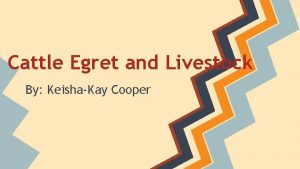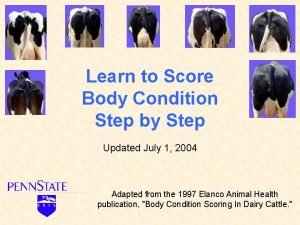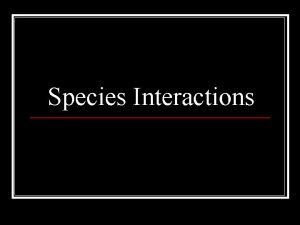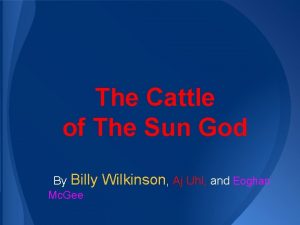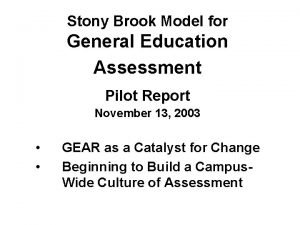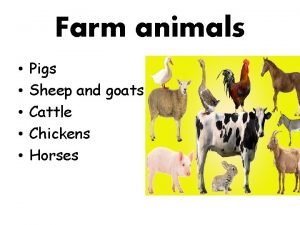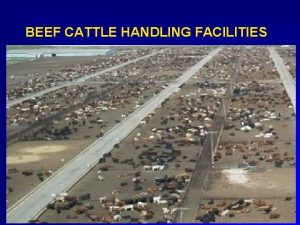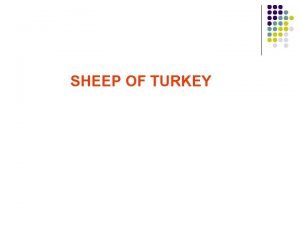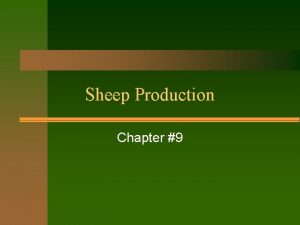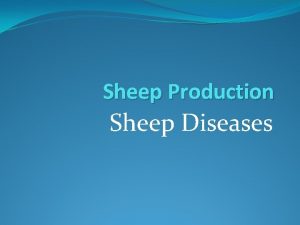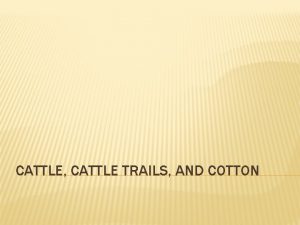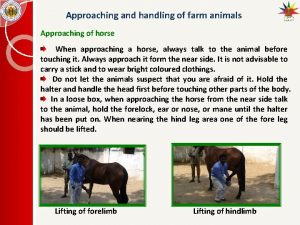Approaching and handling of cattle sheep pigs dogs










- Slides: 10

Approaching and handling of cattle, sheep, pigs, dogs and cat Approaching and handling of cattle The usual practice is to tie the cows in double or single row in byres the cows are approached from the right side in byre. The terms near and off are not applicable to cattle. To examine the head of a horned cow, the assistant standing near the animal should first grasp the horn and the nostrils are held thus keeping the head straight. The horns are always secured before taking hold the nostrils. Bull holders or bull dogs may be applied to the nostril and then restrained. In every case, it is best to talk to it and pat its back while approaching it.

Handling and restraining of cattle

Cont… To restrain a bull pole or bull leader may be used. Generally bulls should be secured before approaching. Ropes may also be used instead of pole. A halter may also be applied. Sometimes a bull mask may be used. A bull mask may be useful in preventing them from seeing straight. It is made up of stout leather and a thin piece of metal sheet. It rests on the front side of the face, and is kept in the place by a noseband with the help of two straps bucked around the horn. Handling and restraining of calves

Approaching and handling of sheep/goat Sheep are held above the hock or placing the left hand underneath the jaw and around the back. Horned sheep can be held by the horns. When holding a sheep, stand on its left side and place the left hand under its jaw, the right hand should reach well under the belly. To turn up a sheep, the attendant should stand against it left side placing his left hand under its neck. Pass your right hand over the right flank as far under the belly as possible and take hold of the wool. Raise the sheep’s fore legs off the ground with the right hand lift the animal into a sitting position in front of the shepherd legs and supported. In horned breeds to avoid injury and to have better control, the horns are held instead of the fore limbs.

Approaching and handling of pig Care must be taken while approaching boars and sows. A pig catcher may be used to secure a large pig. It is made up of a bar of iron (3 feet long) with a handle at one end a (4 inches) ring at the other end. The ring will be slipped round the upper jaw, behind the tusks. Handling of pigs using snare Pig catcher

Securing a large pig Pigs may also be caught by hind legs seized above the hock or by the ears. Large pigs can be secured by Barton’s method. It consists of a stout strap round the girth of the pig and another around the neck. Short straps join these stout straps between the fore legs and on either side of midline. Barton’s method

Moving of pigs The simplest form of aid is a small wooden board with a handle-hole near the top. This board can be used to apply pressure to the side, rear or front of the pig to indicate the direction you wish it to take. Excessive force should not be required to move a pig in any direction. However, pigs will refuse to move if the place you wish them to go to is dark, as would be the case when moving from the day light to a very poorly lit building, or when asking the pig to climb a very steep ramp at the back of a vehicle, or to go along a passage that is too narrow or has too many sharp bends and turnings.

Approaching and handling of dog Tape muzzle is used to prevent them from biting. Dog catcher can be used to secure a dog. Very small dogs may be held by the scruff. The dog should be picked up by both fore legs in one hand may be placed under legs belly and another is used to grip the back of the neck. Then the dog is rolled over gently first on its side and then on to its back. The hind legs are extended backwards and the fore legs forwards, making them to fully expose the chest and the abdomen. To prevent a dog from biting, Elizabethan collar may be applied. Dog catcher Leather box muzzle

Handling and restraining of dog Control by tape muzzle Proper way to lift and carry a puppy or small dog Proper method of lifting a gentle dog Elizabethan collars

Approaching and handling of cat The cat is normally held by the scruff of the neck and a ferret muzzle. It may also be rolled in a piece of large towel. Cat box and modified Elizabethan collar may be used to secure cats. A method of holding the cat is to seize the hind legs above the hock and the fore legs just around the knee joint. Restraining of cat Handling of cat
 Cattle egret and cattle symbiotic relationship
Cattle egret and cattle symbiotic relationship Issa mood meaning
Issa mood meaning Hooks and pins cattle
Hooks and pins cattle Hooks and pins on cattle
Hooks and pins on cattle Range cattle research and education center
Range cattle research and education center Some natural resources such as wheat and cattle are
Some natural resources such as wheat and cattle are Cape buffalo and cattle egrets relationship
Cape buffalo and cattle egrets relationship Odysseus and the cattle of the sun god
Odysseus and the cattle of the sun god Great gatsby chapter 8 summary
Great gatsby chapter 8 summary The giver english
The giver english Approaching meeting exceeding
Approaching meeting exceeding
